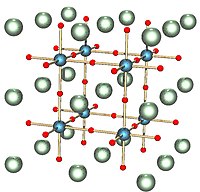
Photo from wikipedia
Perovskite solar cells attract significant interest due to their high-power conversion efficiencies. The replacement of charge-transporting layers using inorganic materials is an effective approach for improving stability and performance, as… Click to show full abstract
Perovskite solar cells attract significant interest due to their high-power conversion efficiencies. The replacement of charge-transporting layers using inorganic materials is an effective approach for improving stability and performance, as these materials are low-cost, highly durable, and environmentally friendly. This work focuses on the inorganic hole and electron transport layers (HTL and ETL), strontium ferrite (SrFe2O4), and zinc oxide (ZnO), respectively, to enhance the efficiency of perovskite solar cells. Favorable band alignment and high charge-collection capability make these materials promising. Experimental and computational studies revealed that the power conversion efficiency of the fabricated device is 7.80% and 8.83%, respectively. Investigating electronic properties and interface charge transfer through density functional theory calculations further corroborated that SrFe2O4 is a good HTL candidate. Our numerical device modeling reveals the importance of optimizing the thickness (100 nm and 300 nm) of the HTL and perovskite layers and defect density (1016 cm−3) of the absorber to achieve better solar cell performance.
Journal Title: Nanomaterials
Year Published: 2022
Link to full text (if available)
Share on Social Media: Sign Up to like & get
recommendations!